|
|
Related: |
William Mulholland (1855 - 1935)
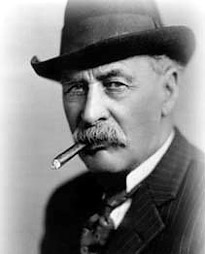 A case in point is William Mulholland, the man who was honored by having a major street in Los Angeles named after him. What did he do to deserve the honor of becoming the namesake for Mulholland Drive? He was an Irish immigrant with minimal formal education who taught himself the craft of engineering and then rose to the top to become superintendent and chief engineer of the Los Angeles water department. In that position he oversaw the construction of the 233-mile Los Angeles Aqueduct, which was finished in 1913 ahead of time and under budget. The aqueduct brought much needed water from the Owens River into Los Angeles. The water was critical to the city's dreams for the exceptional growth and glory that it enjoys today. Yet deceit and corruption were involved to take away water rights from Owens Valley farmers and other residents who had different plans for the River. Mulholland's financial backers became rich off of the water bonanza while members of Owens Valley suffered complete financial ruin. Some called it "The rape of Owens Valley." At the opening ceremony for the aqueduct, Mulholland uttered his most enduring quote, "There it is. Take it." I believe a form of this quote echoes repeatedly throughout Lynch's movie as character after character repeats Diane's infamous words, "This is the girl." Each time those words are uttered, the context is such that the character might as well continue on and say, "Take her," since like William Mulholland they appear to be delivering a type of commodity who is being given over for some type of momentous consumption. However, when the commodities are human beings they do not always survive the consumption.
A case in point is William Mulholland, the man who was honored by having a major street in Los Angeles named after him. What did he do to deserve the honor of becoming the namesake for Mulholland Drive? He was an Irish immigrant with minimal formal education who taught himself the craft of engineering and then rose to the top to become superintendent and chief engineer of the Los Angeles water department. In that position he oversaw the construction of the 233-mile Los Angeles Aqueduct, which was finished in 1913 ahead of time and under budget. The aqueduct brought much needed water from the Owens River into Los Angeles. The water was critical to the city's dreams for the exceptional growth and glory that it enjoys today. Yet deceit and corruption were involved to take away water rights from Owens Valley farmers and other residents who had different plans for the River. Mulholland's financial backers became rich off of the water bonanza while members of Owens Valley suffered complete financial ruin. Some called it "The rape of Owens Valley." At the opening ceremony for the aqueduct, Mulholland uttered his most enduring quote, "There it is. Take it." I believe a form of this quote echoes repeatedly throughout Lynch's movie as character after character repeats Diane's infamous words, "This is the girl." Each time those words are uttered, the context is such that the character might as well continue on and say, "Take her," since like William Mulholland they appear to be delivering a type of commodity who is being given over for some type of momentous consumption. However, when the commodities are human beings they do not always survive the consumption.
William Mulholland's commodity trafficking only involved water, but even his star ultimately failed to survive. Tragedy struck as Mulholland sought to bring into the city more and more water. The St. Francis Dam was one of the dams he had built for this purpose, but it collapsed in 1928 killing almost 500 people in the resulting flood. He resigned under criticism that he had filled the reservoir too quickly and that he had not sought after any independent expert opinion during the entire project. In essence, the claim was that he had gotten too cocky and his own hubris brought him down. Whether or not Mulholland was at fault for the collapse is still under dispute, but he took full responsibility saying, "If there is an error of human judgment, I am the human." Like Mulholland, we are all only human, and Lynch makes us take a very intimate look at how human judgment is prone to flaws and errors, and especially when it comes to engaging in the dream and the legend that is Hollywood.
Interestingly enough, I believe [Diane's story] begins like the story of the rise of William Mulholland, with someone who lived through a difficult childhood trying to overcome it by creating a pathway leading out of a deep river that will flow triumphantly into Los Angeles. This is what happened with William Mulholland in a literal sense. Yet it happens metaphorically with Diane Selwyn, the protagonist who is the dreamer in Lynch's film. She comes from Deep River, Ontario, and she too tries to rise above a childhood that was tragic by forging a pathway to Los Angeles. In an interesting twist on the parallel between Mulholland and Diane, Mulholland helps to perpetrate a metaphoric rape when he gets older, while Diane suffers from the real thing when she is just a child. However, both are responsible for extreme tragedies at the twilight of their lives. - (Alan Shaw)
Link: William Mulholland & the Collapse of St. Francis Dam
Rita Hayworth (1918 - 1987) *possible connections to Rita/Camilla are marked in bold
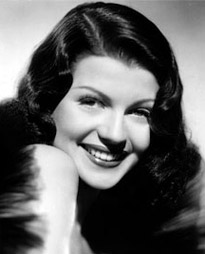 Rita Hayworth's life might serve as the prototype for that of the glamorous movie queen, the classic story of the beautiful young woman trapped in a profession that took over her life in ways she found difficult to understand, much less control. It's
about the transformation of an unknown dancer named Margarita Carmen Cansino
into a Hollywood mega-star, Rita Hayworth.
Rita Hayworth's life might serve as the prototype for that of the glamorous movie queen, the classic story of the beautiful young woman trapped in a profession that took over her life in ways she found difficult to understand, much less control. It's
about the transformation of an unknown dancer named Margarita Carmen Cansino
into a Hollywood mega-star, Rita Hayworth.
Margarita Carmen Dolores Cansino was born on October 17, 1918 in New York City. Her parents came from Seville, Spain. Born into a show-business family, Margarita went to work early as a dancing partner for her father, Eduardo Cansino of The Dancing Cansinos. When Margarita was eight years old, the Cansino's moved westward, near Hollywood, where Eduardo opened a dancing school on Sunset and Vine Streets and landed a few jobs as choreographer in movie musicals. Some sources claim that Rita was sexually abused by her father when she was 12.
In the early 1930s while dancing in her father’s act, Margarita was noticed by the head of Fox Studio, Winfield Sheehan. He signed her to a contract, and Hayworth soon made her film debut in "Dante’s Inferno" in 1935. After appearing in five small roles, her contract was dropped. During this time, she was married to her first husband, Edward Judson. Through his constant promotion, Edward soon had his beloved bride signed to a contract with Columbia.
Then in late 1938, director Howard Hawks began looking for an actress to cast as Judy MacPherson in his upcoming film starring Cary Grant and the reigning queen of Columbia Pictures, Jean Arthur. This is an episode in Rita's life that has at least half a dozen variations, but the most likely story is that after Hawks made a screen test of her, Rita got the part. The movie was Only Angels Have Wings. It was Rita's best film to date and gave a much-needed boost to her career. It made her name much better known and convinced studio head Harry Cohn to begin building up the publicity on her. She started getting better roles and began to be sought after by other studios for supporting roles in "A" films. Cohn changed Margarita’s name to Rita Hayworth and had her sent for electrolysis to raise her hairline:
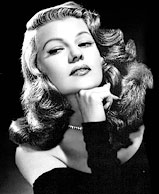 Her
crossover from Tijuana nightclubs to the Californian hills includes not
only a name change - a common practice for many film stars - but also a
bodily "de-ethnization". Her undetermined Roma or Hispanic
background, detectable by the film moguls in her low forehead and thick,
dark hair, was purposefully erased through a painful and long-term
procedure of electrolysis which permanently raised her hairline, thus
"Americanizing" her appearance. The essay highlights the irony
of how the subject's inscription into history is a simultaneous
confirmation of other influential powers, in this case, those dictating
the value of Latino subjects.
Her
crossover from Tijuana nightclubs to the Californian hills includes not
only a name change - a common practice for many film stars - but also a
bodily "de-ethnization". Her undetermined Roma or Hispanic
background, detectable by the film moguls in her low forehead and thick,
dark hair, was purposefully erased through a painful and long-term
procedure of electrolysis which permanently raised her hairline, thus
"Americanizing" her appearance. The essay highlights the irony
of how the subject's inscription into history is a simultaneous
confirmation of other influential powers, in this case, those dictating
the value of Latino subjects.
The Hayworth image was always sexy and alluring, but she didn't play in only one type of film. She was the dancing star of 1940s escapist musicals, and at the same time she played femmes fatales in a series of films noir. Two of the most financially successful and best remembered films of the war years starred Hayworth: the musical Cover Girl, in which she co-starred with Gene Kelly, and the sexually suggestive Gilda (1946), opposite Glenn Ford.
 In Gilda she is used and abused by more than one man, and her apparent passivity allows her to be victimized and degraded, culminating in her famous striptease "Put the Blame on Mame, Boys." Hayworth's image as a destructive but pliable woman seemed to stick with her after Gilda. "Every man I've known has fallen in love with Gilda and wakened with me," she allegedly told a friend.
In Gilda she is used and abused by more than one man, and her apparent passivity allows her to be victimized and degraded, culminating in her famous striptease "Put the Blame on Mame, Boys." Hayworth's image as a destructive but pliable woman seemed to stick with her after Gilda. "Every man I've known has fallen in love with Gilda and wakened with me," she allegedly told a friend.
In 1943 Rita Hayworth married the director Orson Welles (reference to the director Adam Kesher as Camilla's huband-to-come?) after latter called off plans to wed star-actress Dolores Del Rio. (Note: Rita and Welles later had a daughter named Rebecca). Welles (creator of Citizen Kane), used Hayworth's image as a passive yet destructive temptress in his film The Lady from Shanghai:
Written and directed by Orson, the film is a massive personal statement about their relationship and it is almost chilling in places to realise the analogies weaved into the film. More positively, Orson gave Rita a chance to break from her image by cutting her hair short and dying it platinum blonde. However, due to this change in image and editorial interference from the studio, the film bombed. (Rita Hayworth's looks)
Whether Hayworth played in musicals or dramas, she was always the ultimate in desirability.
For a short duration, Hayworth was even a pin-up girl like Betty Grable. Even a test A-Bomb was named Rita and had a picture of her painted on it.
When in 1948 Life magazine dubbed her "The Love Goddess," she was officially marked with the tagline that would plague her the rest of her life. The issue coincided with the release of her film
Down to Earth, in which she played the Greek goddess of dance, Terpsichore. Her image as a woman men could not resist was further enhanced by her five unhappy marriages, in particular her wedding to Prince Ali Khan in 1949.
This publicity bonanza, fully exploited by the tabloids, made Hayworth into an international celebrity. She soon returned to Hollywood, however, and resumed her career, although she would never regain the fame she had in the 1940s. Hayworth continued to perform during the 1960s and 1970s, occasionally trying her hand at television or a serious drama, such as her role in Rattigan's Separate Tables, for which she received good reviews. Hayworth's most famous and successful films, musical or dramatic, tend to deal with her as a woman whose image does not truthfully reflect her personality, and for whom success, riches, and beauty bring no real and lasting personal satisfaction. Sadly enough, it seemed to be the story of her own life.
Finally she became probably the best-known victim of Alzheimer's disease (Rita's amnesia as subtle reference?). The diagnosis wasn’t made until 1980, but because of the progression of the disease, Miss Hayworth was given smaller roles. In 1981, Rita Hayworth was no longer able to take care of herself. She died on May 14, 1987, in New York at age sixty-eight.
| Related: "Gilda" references in MD | Rita |
Marilyn Monroe (1926 - 1962)
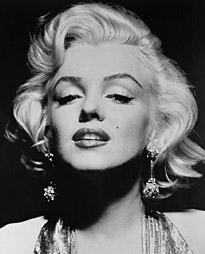 Marilyn Monroe,
Hollywood's most famous sex symbol, has become a notable object of fascination for David Lynch. He
even dedicated a song
to her on Blue Bob,
his cowritten album which has two tracks featured in MD ("Mountains Falling" and "Go Get
Some"). Here's a list of possible real life connections between Marilyn and Betty/Diane:
Marilyn Monroe,
Hollywood's most famous sex symbol, has become a notable object of fascination for David Lynch. He
even dedicated a song
to her on Blue Bob,
his cowritten album which has two tracks featured in MD ("Mountains Falling" and "Go Get
Some"). Here's a list of possible real life connections between Marilyn and Betty/Diane:
-
Marilyn was raised in foster care and knew her mother only as "that woman with red hair" who came to visit.
-
Marilyn was asked to refer to her foster mother as her aunt.
-
Marilyn was sexually abused as a child most extensively by a male boarder in her foster home. When she tried to tell her foster mother, she was basically told to shut up about it because it couldn't have happened plus they needed the money. »see this article
-
Marilyn’s demeanor, voice, and many other characteristics emulated a sexualized little girl. Her screen persona was childlike and innocent, but she gained attention and affection through a sexual persona. Now think of the audition scene.
-
Marilyn's untimely death at the age of 35 led to years of speculation, presumably she committed suicide.
-
Twin Peaks: Originally Lynch and Mark Frost were working on some sort of project (documentary?) about Monroe. Eventually it became Twin Peaks and many things about her life filtered through into the series. Things such as Marilyn's public facade hiding her inner turmoil. Laura, (like Marilyn) became trapped by people's image of her and lost her identity. Laura's relationship with Dr. Jacoby is similar to Monroe and her therapist etc.
Thread: Marilyn Monroe - MD connections - (Bob)
Peg Entwistle (1908 - 1932)
She became a symbol of failure and tragedy, Hollywood style.
 The blonde, blue eyed actress was born Lillian Millicent Entwistle, in Port Talbot, Wales in 1908. Her mother died when Peg was very young. Peg’s father decided that they should move to New York and the father found work there in a theater. Peg had another unfortunate incident in her early years. Her father died suddenly one day when he was hit by a truck on Park Avenue. Peg’s brothers were sent to live with their uncle, and Peg struck out on her own as an actress at the age of 17. By 1931, she was in 8 consecutive Broadway shows - that flopped. Hollywood (or course) beckoned, and she came to
L.A. She moved in with her Uncle Harold at 2428 Beachwood Drive, in Beachwood Canyon. Just down the hill from the famous
"Hollywoodland" sign.
The blonde, blue eyed actress was born Lillian Millicent Entwistle, in Port Talbot, Wales in 1908. Her mother died when Peg was very young. Peg’s father decided that they should move to New York and the father found work there in a theater. Peg had another unfortunate incident in her early years. Her father died suddenly one day when he was hit by a truck on Park Avenue. Peg’s brothers were sent to live with their uncle, and Peg struck out on her own as an actress at the age of 17. By 1931, she was in 8 consecutive Broadway shows - that flopped. Hollywood (or course) beckoned, and she came to
L.A. She moved in with her Uncle Harold at 2428 Beachwood Drive, in Beachwood Canyon. Just down the hill from the famous
"Hollywoodland" sign.
She got a part in a play that included Humphrey Bogart and Billie Burke who later played the good witch in the Wizard of Oz. But the play only ran for a week and a half before closing. She did do other plays but nothing became of it. When she got a part in an RKO film called "Thirteen Women" she thought her luck had turned and this would be the start of something big. Unfortunately, most of Peg's screen time wound up on the cutting room floor. In the brutal Hollywood summer heat of 1932, her once promising career came to a standstill. Her luck had changed, but from bad to worse. She tried for small time parts and went to numerous auditions and casting calls trying to get any acting work that she could. Then her short term contract with RKO ran out and was not renewed. She was on her own and couldn’t find any work even in the theater. Her friends started to desert her and she was broke. She tried to save enough money to go back to New York, but couldn’t even manage train fare. The beautiful young actress was badly depressed as she sensed her career was done.
On the night of September 18, 1932, she told her Uncle Harold that she was going to walk up Beachwood Drive to the drug store, and then to visit friends. Instead she climbed her way up the tough, steep, hill through the brush to the Hollywoodland sign. She took off her coat, folded it neatly, and placed it with her purse at the base of the maintenance ladder which led up the letter H. She then climbed up the ladder to the top of the 50 foot letter H and jumped to her death down the hill to the rocks and brush below, dying at the age of 24. Peg’s body was discovered two days later in the brush at the base of Mount Lee.
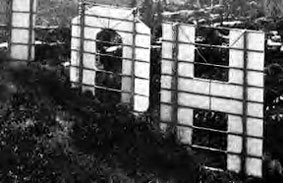 Here’s the ironic
part:
Here’s the ironic
part:
Two days later Pegs uncle opened a letter addressed to Peg from the Beverly Hills Playhouse. It was mailed the day before she jumped. In it was an offer for her to play the lead role in their next play, It would be a role where her character commits suicide in the final act.
In the following years, hikers and later park rangers would report very strange happenings in the area around the Hollywood sign known as Griffith Park. Many people have reported sightings of a woman dressed in 1930’s era clothing who vanishes when approached. She has been described as a very attractive, blond woman, who seems very sad. There are also many cases of people being overwhelmed with the smell of gardenia perfume which was known to be Peg’s favorite perfume.
Known as the ghost of the Hollywood sign, in death Peg Entwistle finally has the fame she sought in life. Her death completely overshadowed any of the merits she may have had as an actress in life.
Thread: Diane and Peg Entwhistle/Black Dahlia
 I had this idea that perhaps the reason Lynch doesn't like to give explanations has something to do with the fact that his films are very personal to him, in that many of the scenes are reflections of his own life and to explain his films would mean to divulge personal details about his private life that he doesn't feel comfortable talking about. Eraserhead seems to be about his troubles with married life and being a father(among other things).
I had this idea that perhaps the reason Lynch doesn't like to give explanations has something to do with the fact that his films are very personal to him, in that many of the scenes are reflections of his own life and to explain his films would mean to divulge personal details about his private life that he doesn't feel comfortable talking about. Eraserhead seems to be about his troubles with married life and being a father(among other things).
One possible example in Mulholland Dr. might be Rita/Camilla who sleeps with the director to get the lead part. Perhaps this is a reference to Isabella Rossellini who began a relationship (affair?) with Lynch around the time when Blue Velvet was being filmed. Both were married and it possibly lead to both their divorces which correlates with Adam's divorce and Camilla leaving Diane. - (JakeTheRipper)
Thread: Connections between Lynch and MD
